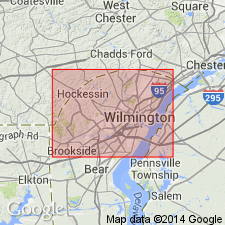
- Usage in publication:
-
- Christianstead Gneiss
- Modifications:
-
- Original reference
- Dominant lithology:
-
- Gneiss
- AAPG geologic province:
-
- Piedmont-Blue Ridge province
Summary:
Pg. 13-14; W.S. Schenck and others, 2000, Delaware Geol. Survey, Geol. Map. Ser., no. 10, scale 1:36,000. Christianhead Gneiss of Wilmington Complex. Coarse-grained, foliated granodioritic gneiss. Major minerals are biotite, microcline, plagioclase, and quartz. Includes thin layers of fine-grained foliated amphibolite plus large pegmatites. Intrudes Windy Hills Gneiss on the east; along southern margin is covered by Coastal Plain sediments; to the north the pluton abuts the Wissahickon Formation. Igneous zircons from a sample of granodiorite (locality Ca44-d2) yielded a U-Pb age of 488 +/-8 Ma (J.N. Aleinikoff, USGS, personal commun., 2000). [Age is considered Late Cambrian to Early Ordovician; the Cambrian/Ordovician boundary is approx. 485 Ma.]
Source: Publication.
For more information, please contact Nancy Stamm, Geologic Names Committee Secretary.
Asterisk (*) indicates published by U.S. Geological Survey authors.
"No current usage" (†) implies that a name has been abandoned or has fallen into disuse. Former usage and, if known, replacement name given in parentheses ( ).
Slash (/) indicates name conflicts with nomenclatural guidelines (CSN, 1933; ACSN, 1961, 1970; NACSN, 1983, 2005, 2021). May be explained within brackets ([ ]).

